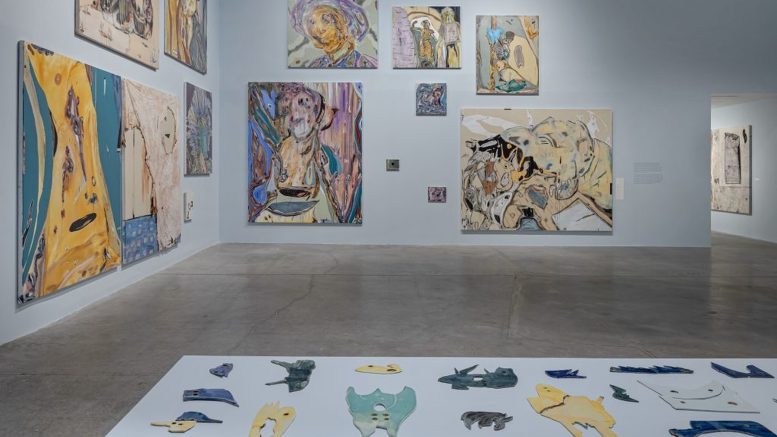A new solo exhibition featuring Manuel Mathieu called World Discovered Under Other Skies is currently on display at Plug In Institute of Contemporary Art (Plug In ICA).
World Discovered Under Other Skies is comprised of large-scale paintings, unconventional ceramic tiles and drawings which address a wide variety of topics. Curated by Amin Alsaden, the exhibit is sure to intrigue those who are interested in the expansion of painting into multimedia installations that speak to identity, politics, history and the common links that unite us all.
More specifically, the exhibition “sheds light on Haiti’s relationship to the world” and the blurred boundaries between the personal and political and the past and present Mathieu sees as a fundamental part of both global and personal histories.
The exhibition is installed in both of Plug In ICA’s galleries and conveys two distinct energies between them.
The first room, which holds the bulk of the exhibition, discusses topics such as Haiti’s history of slavery, colonialism and dictatorships and their impact locally and globally, and other economic and political aspects that have impacted the country over the years.
Within this dimly lit room is a multitude of large-scale multimedia paintings and a long, low table covered with ceramic pieces in shapes that mimic the forms in Mathieu’s paintings.
This contrasts significantly with the second room, which is illuminated by natural light coming in through a wall of windows, making the energy of the space feel lighter. The works here differ slightly in subject compared to the first room, focusing mainly on belonging, police brutality, the fragility of life and ultimately our collective responsibility toward each other. The overall change in tone is refreshing, as it allows one to think about the different subjects more clearly.
The second room also contains a table of ceramic pieces that speak to the paintings on the walls around them, as well as some drawings in one corner of the room, which highlight Mathieu’s artistic and experimental processes rather than speaking to the broader narratives at play in the rest of the exhibition.
Mathieu approaches the topics and ideas of World Discovered Under Other Skies by deftly blending various mediums, vibrant colours, abstraction and figuration in a complex and fascinating way. Mathieu avoids almost all direct and conventional symbolism or representation — and as such, without the gallery’s wall text, it would be quite difficult to discern what the exhibition is about. However, once the idea is planted in your mind, it is impossible to shake, and meaning can be derived from these works through their dynamism, colour palettes and the intensity behind every brushstroke.
Some favourite paintings in the exhibition were “Zapruder/313” and “Study on a Disappearance 1.”
“Zapruder/313” has a certain mystique to its excellent blend of abstraction and figuration. Its palette of neutral-toned green, black, white, grey, yellow and rust-coloured lines and planes of paint seem to swirl and change forms as it’s viewed, transforming into small characters, a room, a landscape and, from the right angle, an up-turned face.
In contrast, “Study on a Disappearance 1” primarily features a warm dandelion yellow and a deep teal. It stands out as one of the few paintings to feature such solid and bold areas of colour, but also for its ambiguous imagery.
With its black, white and maroon accents, “Study on a Disappearance 1” becomes a window into another world that refuses to give up its secrets. Hints of a desert landscape or open water can be seen at the bottom of the canvas, but a black hole painted above skews the perspective back into abstraction. Small markings along the sides and corners aid in creating movement, and pieces of tape around the edges of the painting provide subtle textural intrigue.
The sheer enormity of Mathieu’s paintings dwarfs almost every other art object in the rooms. Their vibrant colours and compelling, abstract brushstrokes draw you deeply into each work, contrasting with the more understated ceramics and drawings.
The drawings, in particular, feel slightly out of place in this show, which may be due to the fact that there were no drawings in the first room. If these drawings had been spread out evenly throughout both rooms or if there had simply been more of them, they may have felt better integrated into the exhibition.
World Discovered Under Other Skies challenges the viewer’s perception of what painting can be and the way it can relate to other mediums in an exhibition. Its conceptualization is strong and provides great insight into history that isn’t as prominent in the public eye.
You can visit World Discovered Under Other Skies by appointment at the Plug In Institute of Contemporary Art until April 3. For more information about Manuel Mathieu, his practice and the exhibition, visit plugin.org.





